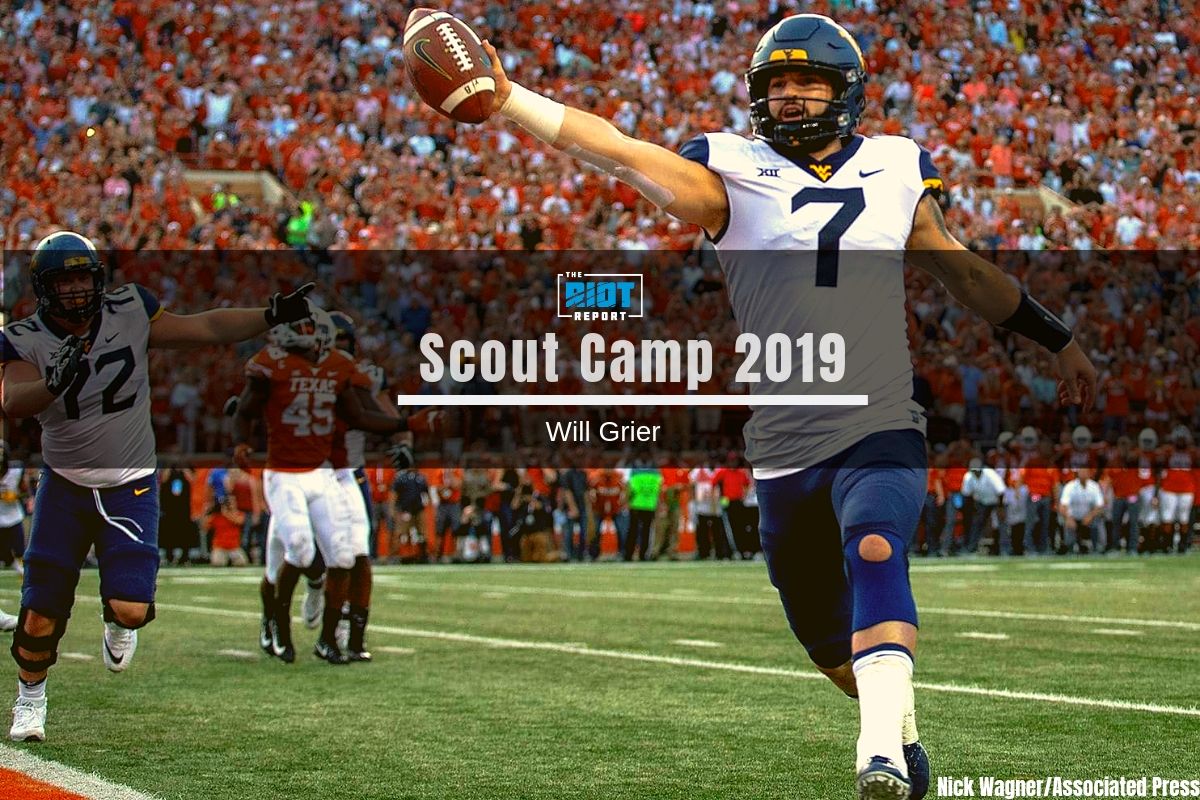The Game Manager Aspect
Judging a quarterback’s ability to work through progressions and make good and quick decisions inside the structure of the offense is always a hard thing to do based on tape alone without inside knowledge of the offense, and this is not made any easier by West Virginia’s offensive scheme – which did a lot to take any decision making responsibility away from the quarterback. By my count, around 20-25% of Grier’s pass attempts were either RPOs, screens, or preset swing passes, and while this isn’t a fault of Grier, it is hard to give him any real credit for the non-throwing aspect of the following plays:
Similar story for the nearly 10% of throws where Grier was just asked to put the ball up in the air and ask the receiver to make a play over the defender, some of which worked and some of which didn’t:
NFL teams do run these plays, but not with the frequency that WVU did and generally in situations where a 50/50 ball is better odds than what they are going to get by trying to work the ball into a tight window down the field – 3rd-and-very-longs being a prime example – but there is no read going on on most of these plays. Even some of the less gimmicky throws were actually not reads at all, but set entirely by defensive formation pre-snap, as can be seen when Grier throws to receivers who very definitely aren’t open:
I don’t think these plays are bad reads, as I’m not sure they’re reads at all. On the first, the plan is for the defense not to pick the running back up as the quarterback rolls right, but they do – and on the second, the corner is expected to drop deep rather than diving on the curl route. NFL teams do run some plays like the former – double screens being an easy example – but for Grier to succeed at the NFL level, he is going to have to do more post-snap than much of what he did at WVU asked or allowed him to do. But how did he fare when he was asked to go through more of a progression on plays?
First, let’s look at what he does well, as he did show some ability to work through reads and find the open receiver, such as on the following play where he recognizes the defense rolling away from the running back wheel and hits the back in stride for a long gain:
And when given time in the pocket, he showed the ability to be patient and work through his reads to find the open man:
However, this is something that should be treated with some degree of caution, as while he does show a nice ability to work back towards the second side of the field at times:
This backside curl was something that WVU ran on a lot of plays, with the plan being that if the front side of the field doesn’t show you what you want, you can work back to the curl against zone – the issue with this is that it wasn’t really a read that Grier made, but rather a default plan B, as can be seen by the times he throws it to a receiver who isn’t really open:
Or even to one who definitely isn’t open:
It’s important to distinguish plays like this where the quarterback’s read is based more on what he doesn’t see from more NFL-type reads, and while it also isn’t Grier’s fault that WVU ran a lot of plays like this, it would be foolish to praise him for the times it works without realizing that this is just as foolish as blaming him for the times it doesn’t.
However, he did show some ability to make concept reads, such as the following:
This can be best viewed in the following image:

This is a variation on the smash concept, with the position of the inside zone defender allowing for a high-low read on the boundary corner; Grier is able to look the corner off on the vertical route, allowing for an easy completion to the underneath receiver. This isn’t the most complex read he’ll have to make at the NFL level, but this is at least an NFL read that he showed the ability to make from a clean pocket.
However, there are a lot of reasons to be cautious about Grier’s ability to work through these reads at speed, especially under pressure, and this was something that really came to the front in the Iowa State game, though it was present in other games as well, just to a lesser extent. Some of the issues in that game can’t really be blamed on Grier, as when WVU ran plays that didn’t offer much over the middle against dropback coverage, he didn’t really have much of a chance to succeed:
This obviously isn’t helped by his arm strength limitations, but even so, this is not great play design. Given that he’s not going to be driving the ball downfield consistently, however, he should do a better job of settling for underneath options early rather than waiting on downfield routes to get open enough for him to try and work the ball downfield:
However, by far his biggest issue is what happens when he’s placed under pressure. On the following play, he has a wide-open zone beater on the near side, but rather than working through his reads and making the easy throw, he gets spooked by the illusion of pressure and breaks the pocket only to be bailed out by a defender losing his man:
The read point is shown here:
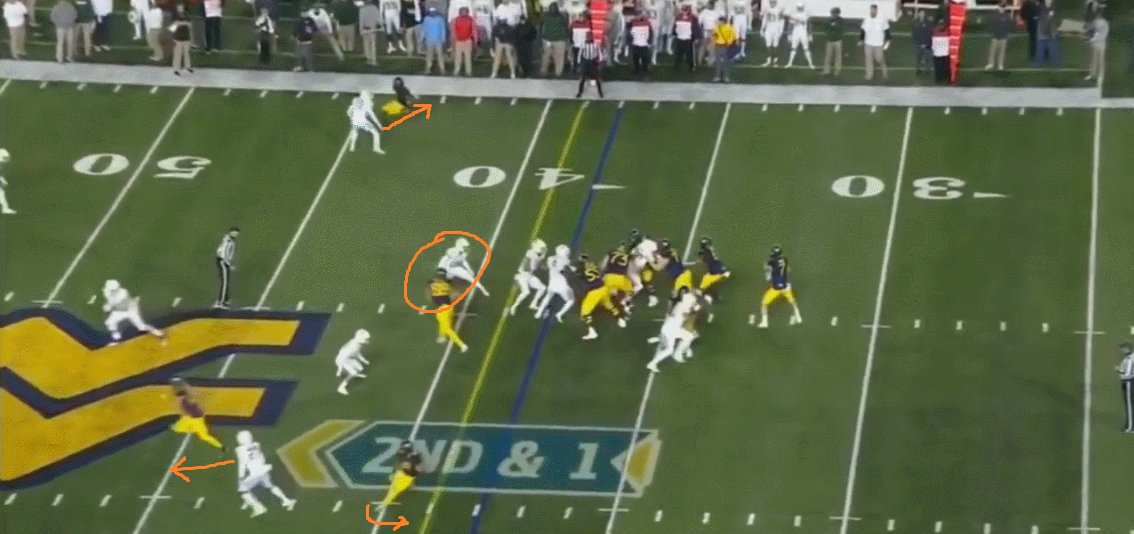
You can see that Grier isn’t really under any imminent risk of being hit, but the man in his face seems to spook him. What can also be seen is just how open the near-side curl is; with the defender breaking upfield to take away the vertical route, the receiver has one half of the field to himself. Grier likely wanted the tight end over the middle, and even this comes open if Grier had stayed in the pocket half a second longer.
Given how important for him it is to work in the pocket and use good footwork and timing to hit tight windows, seeing shadows isn’t great. Also highlighted is how the far-side corner is able to sit on the comeback route, knowing Grier doesn’t have the arm to punish him on a double-move.
He also didn’t do a great job when defenses looked to take away his timing routes, such as on the following play:
Again, this is best seen as a still at the read point:
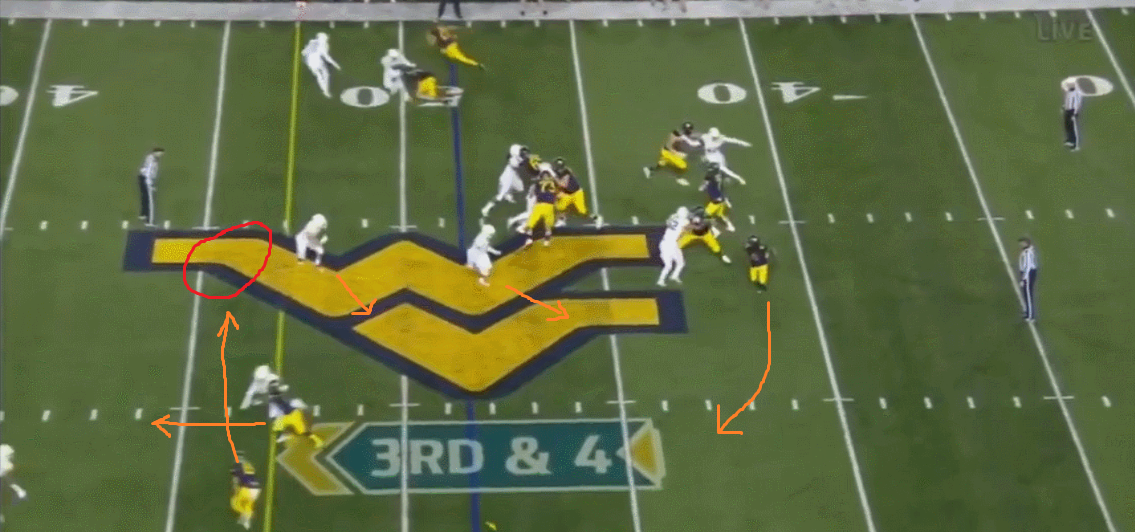
For the most part, this play sort of goes to plan. The vertical receiver is able to rub the drag route open and the running back swing pass is able to clear the underneath linebacker out of the play. However, the second linebacker does a good job of diving under the route, forcing the quarterback to hold the ball a half second longer. By doing this, all the linebacker is doing is shifting the target, as by committing to the near side he then vacated the middle of the field where the drag route will naturally progress to. This isn’t a simple read for a QB to make, and this is one of the less egregious plays by Grier, but when he recognizes this, he would ideally then look to time the ball to arrive at the spot the linebacker has just vacated as the receiver crossed behind him.
This play isn’t the end of the world, and there is genuine pressure on this play, but what this demonstrates is quite how dependent on timing Grier appears to be. When he isn’t able to hit the route at the usual points in time, he tends to struggle, with the best example of this possibly being the following play, where after he recovers the botched snap – and while not under any real pressure – rather than looking to salvage the play, he simply opts to throw the ball away:
Given that he will have even less time in the NFL and that defenses will do more to try and force him to work back to reads, this isn’t hugely promising – even at the college level, this was something that Iowa State was really able to take advantage of. They routinely looked to bring blitzers from unusual positions and Grier didn’t deal well with this.
There is a lot going on on this play, so let’s look again at the read point:
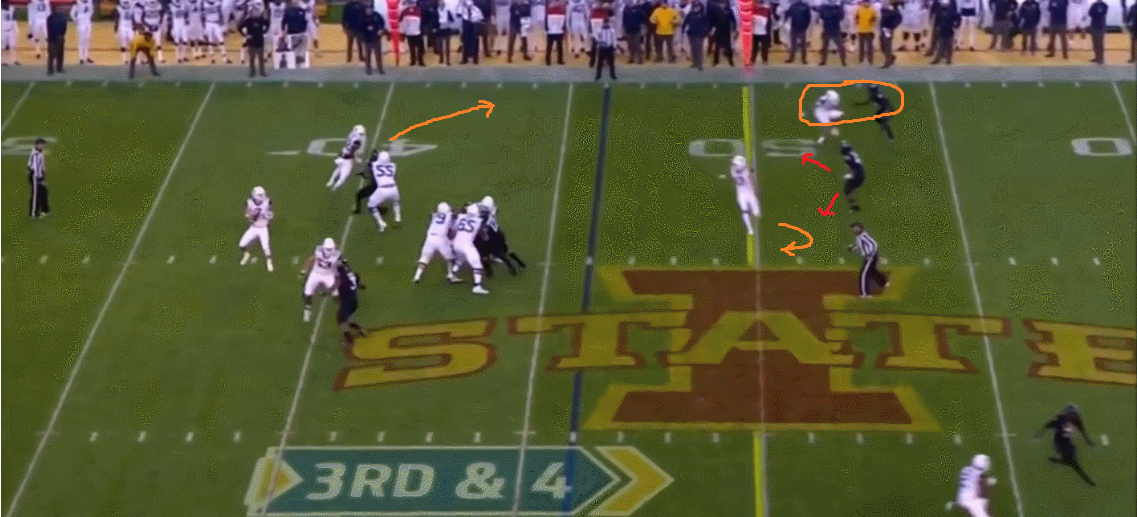
While the defense does bring two linebackers on a blitz, Grier isn’t actually put under any early pressure, and with the two linebackers vacating the middle of the field he really needs to realize that he has a three-on-two underneath on the far side of the field. He seems to be spooked by the pressure and never really progresses away from his first read, despite the fact that with the outside corner occupied with the outside receiver, the inside defender is left caught in no-mans land, allowing an open curl over the middle and a easy YAC opportunity for the running back in the flat.
Similarly, on the following play, they once again bring two blitzers down the middle but don’t generate any early pressure:
It’s not totally clear whether the receiver doesn’t help himself here, but as can be seen in the following image Grier has him wide-open on a seam route with no defender inside fifteen yards of him:
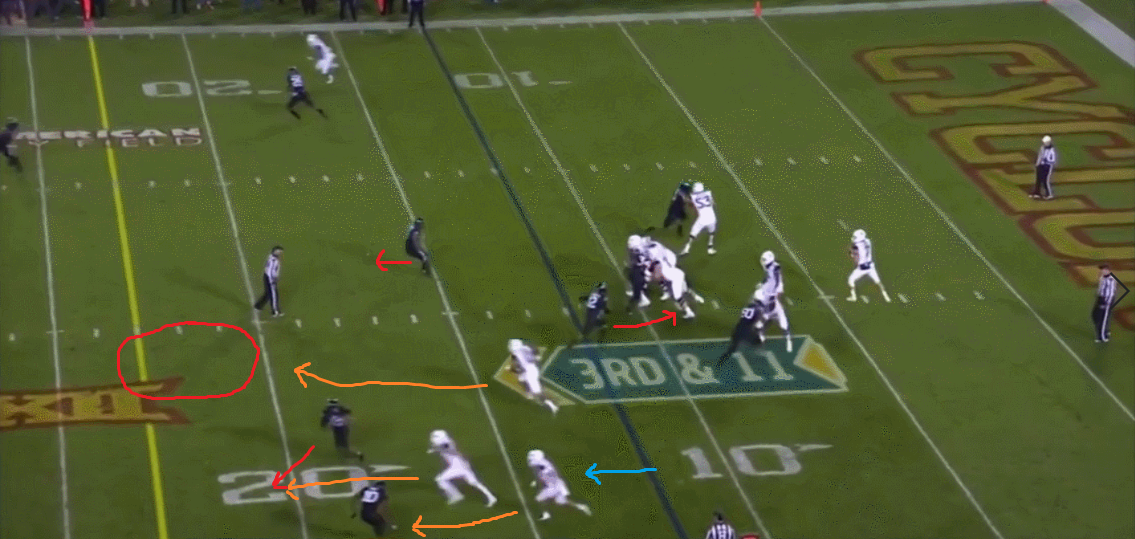
The eventual recipient of the ball on this play is actually the receiver highlighted by the blue arrow, despite the fact that the slot receiver is left completely uncovered. Possibly the best example of how Grier seems to be affected by pressure is another smash concept play similar to the one he was able to execute against dropback coverage earlier:
Let’s stop it at the read point once again:
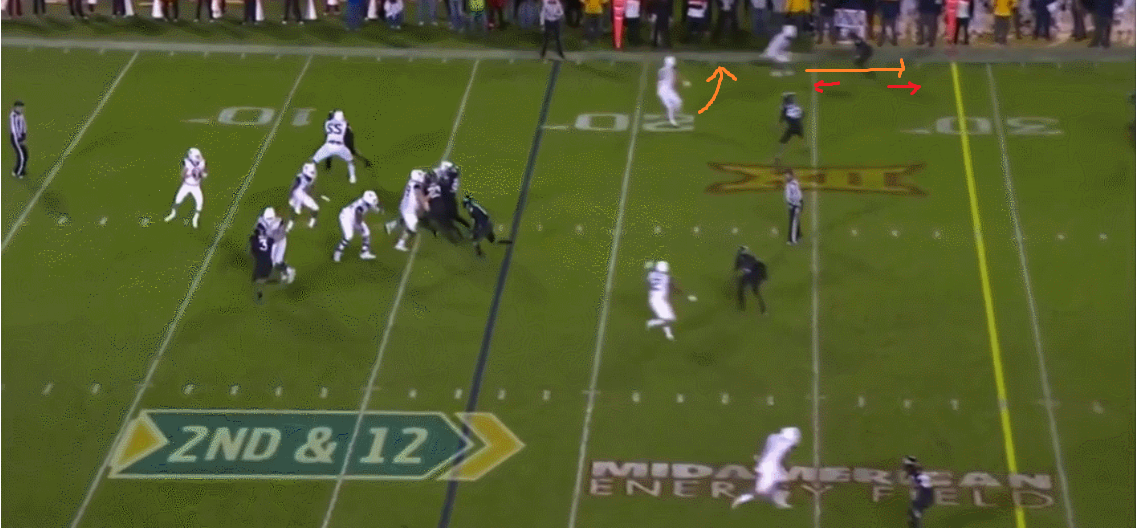
Once again, while the defense brings blitzers through the middle, Grier is left completely untouched with plenty of room to step into the throw. As with the earlier play, he has an inside defender left out of the play with the outside corner forced to chose between the vertical route and the sit-down, but Grier doesn’t initially progress away from the middle of the field. It’s hard to make judgements like this purely from tape, but it seems as though Grier gets lost in the blitz and fails to work through his progressions properly, instead getting getting fixated on where the blitz has come from.
Pulling blitzers out of every orifice in order to confuse a young quarterback is something that Bill Belichick has made his calling card, but it is one thing for a rookie quarterback in a new system and unaccustomed to the speed of the NFL game to be turned into a deer in the headlights by arguably the greatest coach of all time, quite another for a redshirt senior to be bamboozled in this way by a 2-3 Iowa State team.
While his arm strength is limiting, this inability to work through reads quickly and effectively under pressure is by far the most concerning thing about Grier on tape.
If we go back to the players who were able to succeed in the NFL without big arms for a moment, these are exactly the type of reads they excelled at, forcing defenses into dropback coverages that they could then pick apart. If Grier isn’t able to learn to do this, it’s hard to see him succeeding at the NFL level, though as NFL teams are able to test quarterbacks’ mental game in interviews in a way that isn’t possible for those of us on the outside this is something they might believe is fixable.
Grier was also something of a mixed bag when making downfield reads with time to throw, as while he did definitely make some nice reads:
There were a number of times where he either didn’t see the defender or took a somewhat questionable risk:
And I’m not sure what was going on on the following play:
My final, somewhat less significant concern with Grier from a mental point of view is that, while he does show some nice ability to extend plays with his feet:
Sometimes he needs to learn to just throw the ball away, and while trying to keep the play alive on third down might not be the stupidest idea in the world:
Doing so on first down or on manageable second downs is really not a good idea:
In summary, as a pure thrower of the football, Grier shows very nice accuracy and touch and while his arm strength isn’t elite, it is probably good enough for him to be able to play at the NFL level, even if some throws are not things that he is likely to have huge amounts of success with. However, playing quarterback at the NFL level is far more about the ability to master the mental side of the game, and while Grier shows the ability to make some NFL reads from a clean pocket, he makes some questionable decisions when looking to work the ball downfield and really struggles against pressure.
The Panthers might be able to work on this, and I wouldn’t rule out his potential ability to be a functional starter at the NFL level, but I would say that given that he is already 24 years old, developing in this way is less than probable – Will Grier is likely already the player he will be.

